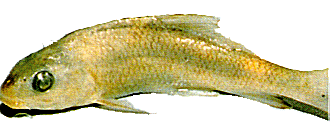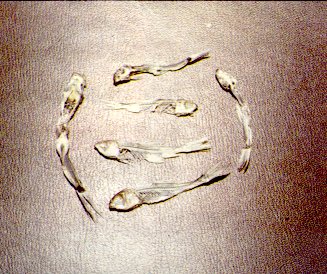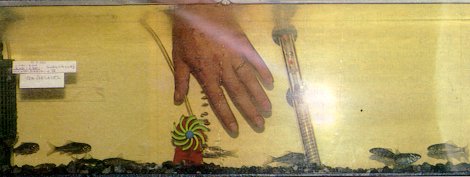|
Where
Doctor Fish Lick Disease
by Dr Levent Undar, Dr
Ali Akpınar and Dr Atilla Yanıkoglou
May 10, 1990 Hospital Doctor Vol C10
No 19 |
PATIENTS
with chronic, intractable disease tend to seek help from
a wide range of alternative sources.
But among
the more bizzare is the treatment given by the socalled
doctor fish of KANGAL.
These
fish can be found in the pools of a hotspring near
Kangal, a small town in Turkey.
The area
is also known for the Kangal dog, a sheepdog, and a
sheep with an extra rib.
The
spring is 13km from Kangal in a tiny settlement,
consisting of a hotel, some pensions, a camping area, a
small restaurant, a market and four bathing pools, three
of which are open-air.
The pools
have concrete walls and floors paved with pebbles and
drain into a stream which runs between the buildings.
|

Licker
... gives relaxing underwater skin message
|

Striker
... a specialist in human skin disease
|
The
water, with a pH of about 7.2, is isothermal and
maintains a temperature of about 35 ° C throughout the
year.
It has
features which make it drinkable(i).
The
presence of selenium (1.3ppm) has been emphasised for
its biological and therapeutic aspects (i).
The
springs were first noticed by people from neighbouring
villages in the early 1800s.
The pools
were built in 1900, and were opened to the public in
1963 (ii).
|
The water
has been reported as being beneficial in rheumatic
disease, neurologic disorders (neuralgia, neuritis,
paralysis), orthopaedic and traumatological sequelae
(fractures, joint trauma, and muscle disease),
gynaecological problems (by lavage), skin diseases,
urolithiasis (by drinking), and psychosomatic disorders
(a report from the Clinic and Institute of Physical
Therapy and Hydrology, Faculty of Medicine Ankara
University, March 2, 1967)(ii).
But
psoriasis is the disease which has made the spring so
popular as a therapeutic aid (ii).
The fish
strike and lick the psoriatic plaque - or plaques of
other skin diseases - which have been softened by the
water.
This
clears away the scales, causes minor bleeding, and
exposes the lesion to water and sunlight.
This may
also cause drainage of pus in patients with abscesses.
|

Down
to the bone ... doctor fish eat their weaker colleaues
|
|
The high
level of selenium in the water, an element the topical
application of which is beneficial in some diseases, is
reported to be the most important factor for wound healing
(i).
Selenium is a co - factor for glutathion peroxidase, an
enzyme protecting cells against the effects of free
radicals (iii). This
may also explain the beneficial effects of water taken by
drinking or by lavage in gastrointestinal and
gynaecological disorders. |
|
Observers,
other than those from Turkey, reported that bathers were
enthusiastic about the doctor fish and none expressed
disappointment (iv).
Wide
interest in the doctor fish encourages people with
neurological and rheumatic diseases to visit the hotspring
to immerse themselves in its pools.
A school of
fish surround the body and strike and lick it.
The initial
pleasant sensation and relaxation of micro-massage
is replaced by a tingling sensation over the skin.
|

Post-prandial
contentment ... a prospective patient is ignored
|
This massage is
given particularly by the younger fish, which need many more
nutrients for their rapid growth.
It may be that,
in addition to the benefits of hydrotherapy from the hotspring,
there is a psychological component to this massage which
generates a feeling of wellbeing in patients with neurologic and
rheumatic diseases, and with traumatic diseases, and with
traumatic sequalae.
The faith of
desperate patients in these sacred fish, and the experience of
being in a different environment may also contribute to this
feeling of wellbeing.
Not only the ill,
but also the healthy, visit the spring to consult the doctor
fish.
People with
healthy skin probably benefit by the fish clearing away
hyperkeratinized portions of their skin.
Two types of fish
are involved. Both are members of the Cyprinidae family and are
adapted to living in a hot milieu (i) (v).
The so-called
striker is Cyprinion macrostomus macrostomus.
It has a terminal
mouth and a length of 15 to 20cm.
It is covered
with relatively large scales, and has six to eight irregularly
arranged lateral spots of various sizes.
The second fish,
known locally as a licker, is Garra rufa obtusa.
It has a
crescent-shaped ventral mouth and a maximum lenght of 19cm. Its
body is also convered with large scales.
The so-called
jabbers are not a third type of fish but the immature from of
the strikers, which lose their lateral spots during maturation
(vi). Both fish are omnivorous, a well-known feature of
Cyprinidae (vii), and feed on phytoplankton and zooplankton.
But only small
amounts of plankton have been found in the pools (i). This is
said to retard the growth and development of the fish, making
them aggressive and predatory (viii).
In winter when
the pools are uncrowded the fish look for food like a flock of
hungry sheep.
In summer, they
assault the human bodies in the pools (i).
They prefer to
attack diseased rather then healthy skin simply because it is
easier to nibble at it.
It has been shown
experimentally that food deprivation is the reason why the fish
eat off man (i).
Fish starved for
21 days in an aquarimun have been observed to search for food
and to strike out at, not only a hand, but also
anythingimmersed: for example, a pencil, or an insect.
Fish fed
adequately in an aquarium did not do this.
Cannibalism has
also been observed. Hungry fish attack and eat weak or injured
fish until only the skeleton is left.
The observation
that the population of fish in the pools remains constant
supports the theory that the fish are cannibals.
The effects of
these feeding habits and the high temperature of the water on
the internal biochemistry of the fish has also been investigated
(viii), (ix).
The role the
doctor fish can play in therapeutic medicine deserves proper
study.
We need to look,
too, at the possiblity that they could transmit hepatitis and
HIV.
-
(i) Fen
Bilimleri Dergisi (Sivas), 1987, Supplement 5,1 (abstract
in English)
-
(ii)Ankara
Bilgi Basımevi, 1969 (in Turkish)
-
(iii)Science,
1983, 220, 472.
-
(iv)The
Lancet, 1989, ii, 1093.
-
(v)Vet
Facult Dergisi (Ankara), 1983, 30, 276 (abstract in
English)
-
(vi)The
Lancet, 1990, i, 470.
-
(vii)Fish
nutrition, New York, Academic Press, 1972.
-
(viii)Doga
Tu Biyol Dergisi (Ankara), 1988, 12, 1 (abstract in
English).
-
(ix) Doga
Tu Biyol Dergisi (Ankara), 1989, 13, 57 (abstract in
English).
-
Dr Undar is
associate professor of internal medicine in the faculty of
medicine, and Dr Akpınar and Dr Yanıkoglou are with the
department of biology in the faculty of science and art,
Cumhuriyet University, Sivas, Turkey. click
here to make online booking
|
|
"DOKTOR
FISH" AND PSORIASIS
|
|